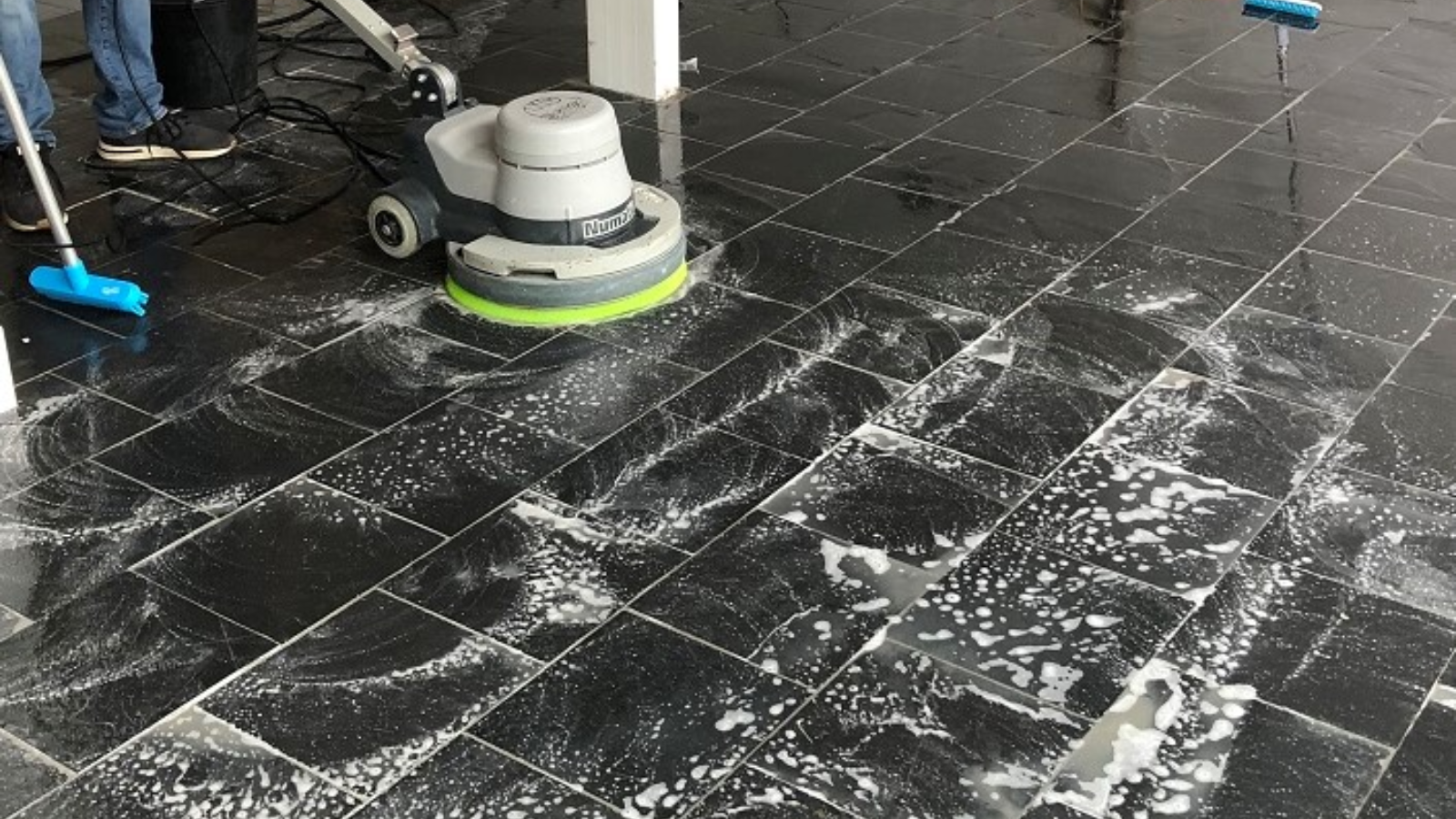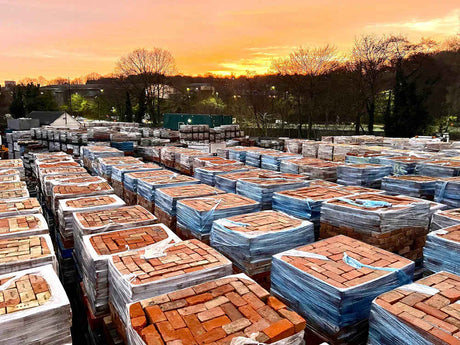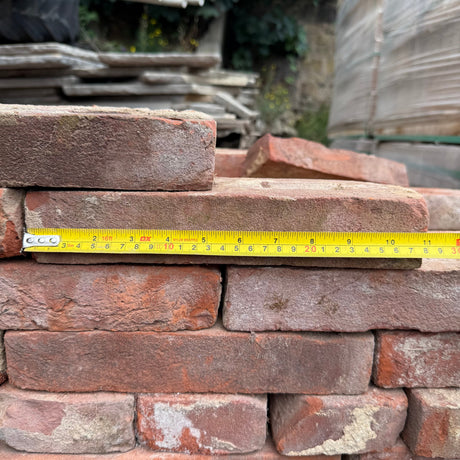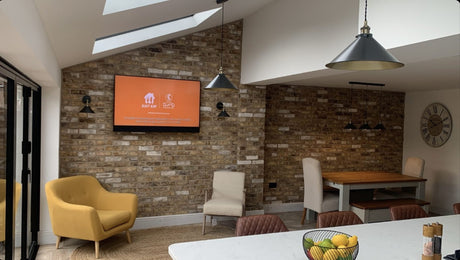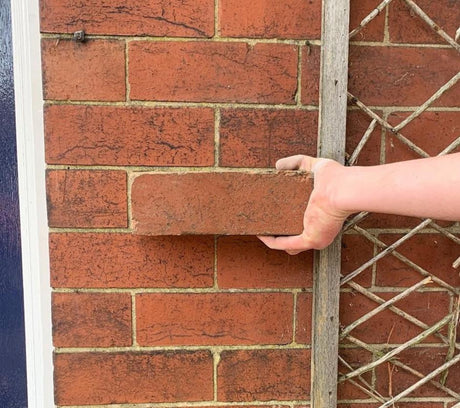Keeping your slate floors looking their best can be a real puzzle. Many find themselves wondering how to clean slate floors without damaging their natural beauty. Slate, being a natural stone, has its own set of care instructions that differ from other floor types.
One interesting fact is that slate is porous, meaning it can easily absorb spills and stains if not properly sealed or cleaned. This blog will guide you through the process of cleaning and maintaining your slate tiles to keep them looking nice and clean.
We'll share a few tips below on regular cleaning, removing tough stains, deep cleaning methods, and why sealing your slate tiles is crucial. Get ready to restore the shine!
What is the Best Way to Clean Slate Floors?
The best way to clean slate floors involves regular sweeping with a soft broom or a dust mop. This removes dirt and debris that can scratch the the stone tile flooring’s surface. For mopping, use warm water mixed with a mild detergent, ensuring it is not acidic as acid can damage the slate tiles.
Homeowners and professionals alike should avoid using bleach or harsh chemicals, as these can etch the stone and degrade its natural stone beauty. For those seeking professional advice and services, consulting a Tile Doctor can ensure the best results for cleaning and maintaining your slate floors.
Next, we will explore how to tackle stains on your slate flooring tiles effectively.
Regular Cleaning Tips for Slate Floors
Maintaining the beauty of slate floors requires consistent care and the right approach. Here are a few tips for some effective tips for regular slate cleaning that architects, builders, contractors, interior designers, and homeowners can easily follow.
-
Dust mop the floor regularly to remove loose dirt and debris. This prevents scratching on the surface of the slate tiles.
-
Vacuum clean your slate floor weekly with a soft brush attachment to ensure deeper cleaning without causing scratches.
-
For mopping, use a mild detergent or soap mixed with clean water to prevent leaving residues on the tiles.
-
Wipe up spills immediately with a clean cotton cloth to avoid stains setting into the porous surface of the slate.
-
Rinse the floor thoroughly with clean water after using any cleaning solution. This helps in removing any potential soap scum or residue.
-
Let the floor air dry or use a dry mop to absorb excess moisture, ensuring that your floors are not left slippery.
-
Employ soft cleaning tools like microfiber mops which are gentle yet effective in picking up dust and grime from textured surfaces.
-
Avoid using acidic or abrasive cleaners as they can etch or scratch the natural stone look of your slate tiles.
-
Schedule an occasional deep cleaning session employing a mild cleaner diluted in warm water for restoring shine and lustre without damaging the grout.
-
Inspect your grout lines periodically; clean them separately if they start looking dingy by using a solution made from water and hydrogen peroxide mixed in equal parts.
Following these steps will help keep your slate floors looking their best while ensuring their longevity and preserving their natural beauty.
Choosing the Right Cleaning Tools for Slate Tiles
After learning the essentials of regular cleaning for slate floors, it's crucial to select appropriate tools that ensure the beauty and longevity of your tiles. One must avoid hard brushes or old brooms that can scratch the surface.
Instead, opt for a soft dust mop or a vacuum cleaner designed for hard surfaces. These tools effectively remove debris without leaving marks on your slate tiles.
A clean slate starts with the right approach to care.
For deeper cleans, microfibre mops work wonders as they pick up dirt without pushing it around. It’s important to use attachments like the soft brush nozzle when vacuuming to prevent accidental scratches.
Always check that the wheels and components of your cleaning equipment are in good condition to avoid dragging grit across your floor. This attention to detail will keep your floors looking pristine.
Using Mild Detergents and Clean Water
Choose mild detergents mixed with clean water to maintain the natural allure of your slate floors. This concoction delicately eliminates dirt without harming the very natural stone tiles. Be sure to utilise a cleaner or mild detergent that’s explicitly crafted for your natural stone tiles and stone tile top surfaces.
The right solution aids in sustaining the integrity of wax layers on the slate, keeping wax layers on it vibrant and damage-free.
Applying this cleaning mixture with a soft mop or sponge allows you to effectively remove dirt without causing scratches to the tiles. It's crucial to refrain from using acidic or abrasive cleaning agents as they can leave marks or dull the finish of the slate over time.
Following this, the attention shifts to handling different types of stains on slate tiles, ensuring their look stays impeccable.

How to Remove Stains from Slate Floor Tiles?
Identifying the type of stain on slate is crucial for selecting the right slate cleaning and method. Oil-based stains, for instance, require a different approach than those caused by water or wine.
To tackle oil-based marks, applying a poultice made from baking soda and warm water, directly onto the stain proves effective. This mixture lifts the oil out of the slate without damaging its surface.
For other stubborn stains, hydrogen peroxide mixed with baking soda creates a powerful solution that breaks down the mark without harming the natural beauty of your slate tiles. For particularly stubborn stains, Tile Doctor products are highly recommended for their effectiveness and safety on natural stone surfaces.
Avoiding abrasive and acidic cleaners is essential to protect against damage to your slate floors. Products containing lemon, vinegar, or bleach can etch or dull the finish of natural stone like slate.
Instead, use mild detergents diluted in clean water for routine cleaning and maintenance efforts to keep your floors looking their best over time. The gentle approach ensures that your slate remains pristine and beautiful while effectively removing spills or stains that may occur during daily life in kitchens, bathrooms or other areas with this versatile flooring option.
Identifying Different Types of Stains on Slate
Slate, a metamorphic rock, often graces floors with its natural beauty. Yet, it can fall victim to various stains over time. Water spots and rings are common if the slate is not properly sealed.
These appear as lighter areas that disrupt the uniform look of cleaning tiles on your floor. Grease stains from food spills penetrate deep into slate cleaning tiles without sealant, creating dark spots.
Proper care and maintenance are key to preserving the appearance of your slate.
Organic stains from leaves, coffee, or wine leave a brownish or pinkish tint that mars the surface aesthetics. To identify these correctly, one must note their colour and location; outdoor slates are more prone to organic staining due to exposure to natural elements.
Ink spills from pens or markers result in stubborn bluish-black marks on interior slate floors, especially in office spaces or kids' areas where accidental spills occur frequently.
Understanding these types can guide targeted cleaning efforts for restoring slate's appeal.
Using Hydrogen Peroxide and Baking Soda
After identifying the types of stains on your cleaning slate tiles, a mix of hydrogen peroxide and baking soda can work wonders. This combination is perfect for lifting tough stains from natural slate tiles.
You simply mix a small amount of baking soda with enough hydrogen peroxide to form a paste. Apply a few drops of this paste directly onto the stain on the floor and allow it to sit for several to ten minutes each.
The chemical reaction between these two substances helps break down the stain, making it easier to scrub away.
To remove the mixture, use a soft cloth or sponge dampened with clean water. Gently, gently rub it over the treated area gently rub it in circular motions until you completely lift off the residue. This method avoids using harsh chemicals that could damage your beautiful slate tiles over time.
It's an effective way to tackle grease or other stubborn marks without risking harm to your floors' finish or integrity.
Avoiding Abrasive and Acidic Cleaners
Cleaning slate floors requires caution, especially regarding the type of cleaners used. Abrasive and acidic cleaners can damage the natural beauty of slate tiles. These substances can etch the surface, leaving it more susceptible to stains and scratches.
It's best to opt for pH-neutral floor cleaner solutions specifically designed for either stone tile or tile surfaces. This approach helps preserve the integrity of the slate while ensuring it remains clean and vibrant.
For those looking to maintain their slate in top condition, steering clear of harsh chemicals is crucial. Products containing bleach or ammonia should be avoided as they can dull the natural sheen of your tiles over time.
Instead, using mild detergent mixed with clean water offers a safe alternative that won't harm your floors. Regular cleaning and maintenance with these gentler products will keep your slate looking pristine without risking damage from abrasive or acidic solutions.

How to Perform Deep Cleaning on Slate Floors?
Deep cleaning slate floors revitalises their appearance and extends their lifespan. This process removes built-up grime that regular cleaning can miss, ensuring your floors remain stunning and durable. For a thorough and professional deep clean, consider using Tile Doctor products specifically designed for slate floors.
-
Prepare the slate floor by removing all furniture and rugs, giving you unobstructed access to the entire floor.
-
Sweep the floor thoroughly to remove loose soil, dust, and debris. Using a vacuum cleaner designed for tile and stone can enhance this step by extracting dirt from crevices.
-
Mix a mild cleaning solution by combining water with a few drops of slate cleaner or a pH-neutral detergent. Avoid using acidic solutions as they can damage the slate.
-
Mop the floor with the cleaning solution, using a well-wrung mop to avoid over-wetting the tiles. Slate floors can become slippery if too much water is used.
-
Focus on one section at a time, applying the solution onto the slate gently but effectively breaking up any grime or grease.
-
For tough stains, create a paste using baking soda and water then apply it directly onto the stain. Let it sit for 10-15 minutes before scrubbing lightly with a soft brush.
-
Rinse the floor with clean water to remove any residue from the cleaning products. Change your rinse water frequently to keep it clean.
-
Dry the slate thoroughly with towels or allow it to air dry completely before walking on it or replacing furniture. Slate retains moisture, so ensure it’s entirely dry to prevent slips or mould growth.
Following these steps will deeply clean your slate floors without damaging them, protecting against stains and ensuring they retain their natural beauty for years to come.
Preparing Your Slate Floor for Deep Cleaning
Before starting the deep cleaning process, ensure your slate floor is free from dust and debris. Sweep or vacuum the floor thoroughly to remove loose dirt. This step prevents scratching the tiles during cleaning.
Make sure all furniture is moved away from the area to provide full access to the tile flooring below.
Next, inspect your slate for any signs of damage such as cracks or chips. Repairing these areas beforehand will protect against further harm during deep cleaning. Use a cleaner specifically designed for cleaning slate tiles; this ensures that you do not damage the tile with harsh chemicals or abrasive materials.
Always test a small, inconspicuous area first to check for any adverse reaction.
After preparing your slate floor, it's time to move on to effective deep cleaning techniques.
Effective Deep Cleaning Techniques for Slate
Deep cleaning slate requires a careful approach to keep its natural beauty intact while ensuring it is clean and sanitary. Start by sweeping or vacuuming the entire floor, to remove loose dirt and debris.
This step prevents scratching during the process. Next, mix a mild cleaning solution with clean water, focusing on using products that are safe for natural stone tiles. Apply this mixture gently on the slate tiles with a soft mop or sponge, taking care not to soak them as excessive moisture can damage slate.
For tougher stains that regular mopping won't clear, create a paste of baking soda and water. Apply this directly onto the stain, allowing it to sit for a few minutes before scrubbing lightly with a soft brush.
Rinse the slate oil and area well with clean water afterwards. Always avoid using acidic cleaners or abrasive tools like steel wool on slate floors as they can etch or scratch the surface. After cleaning, dry the tiles thoroughly with a soft towel or cloth to prevent any water spots from forming.
This method ensures your slate remains pristine and durable over time without compromising its slip resistance or aesthetic appeal.
Rinsing and Drying the Slate Floor Properly
After a deep clean after- cleaning slate tiles, rinsing your slate floor with clean water is crucial. Ensure to remove any residue left by the cleaning solution. Use a damp cloth, mop, or sponge, making sure it is well wrung out to avoid over-wetting the tiles.
Over-wetting can lead to deposits that make floors slippery and dull their appearance.
Drying the floor with damp mop right after rinsing prevents water spots removing stains and marks. Employ soft towels or a dry mop for this task. This step also helps in removing stains and stain resistant surface seal protects against stains and prolongs its beauty.
Applying a thin layer of sealer ensures your efforts in cleaning pay off by keeping your floors looking pristine longer.
How to Seal Slate Tiles After Cleaning?
Sealing slate tiles after cleaning is crucial for protecting the surface from stains ingrained dirt and damage. This process ensures your floors remain beautiful and durable over time.
-
Ensure that your slate tiles are completely clean and dry. Any moisture trapped beneath the sealer can lead to damage.
-
Choose a high-quality slate sealer. Look for products specifically designed for use on natural stone surfaces.
-
Test the sealer on a small, inconspicuous area first. This step checks for any colour changes or adverse reactions.
-
Apply a thin layer of the sealer evenly across the slate tiles using a soft cloth or brush. Avoid leaving any puddles or excess liquid.
-
Allow the first coat to dry thoroughly, following the manufacturer’s instructions on drying times, which could range from a few hours to overnight.
-
Inspect the coverage once the first layer has dried. Apply a second coat of sealer if needed to ensure complete protection against stains.
-
Wait for the second coat to dry completely before walking on the floor or adding furniture back into the room.
-
Maintain sealed slate floors by wiping up spills quickly, using mild detergents for cleaning, and avoiding harsh chemicals.
Next, let's explore common mistakes to avoid when cleaning slate floors and how to clean old slate floors to keep them looking their best.
Why Sealing Slate is Important
Sealing slate tiles after cleaning them is a crucial step to ensure that your floors remain beautiful and durable. Slate, being a metamorphic rock, has natural pores that can absorb spills, leading to stains and damage if left unprotected.
A sealer provides a protective coating that guards against grease, grime, and other substances. It keeps the slate's appearance pristine and makes future cleaning easier.
Applying a thin layer of slate sealer also helps in maintaining the integrity re seal of the floor over time. This process prevents excess water from absorption which can cause cracks during freezing temperatures.
For those involved in building or designing spaces with aesthetic appeal and longevity in mind — architects, builders, interior designers — sealing the slate becomes an essential part of preserving the material’s natural beauty while protecting it from everyday wear and tear.
Applying a Thin Layer of Slate Sealer
Applying a thin layer of slate sealer ensures your clean slate tiles remain protected against stains and damage. Begin by selecting the right type of sealer, ideally one that matches the specific needs of your slate.
A penetrating sealer absorbs into the tiles, offering protection without altering their natural appearance. Start from one corner of the room and work systematically across to maintain an even application.
Use a soft brush or roller for an uniform coat, ensuring you cover all areas thoroughly.
A properly sealed slate floor can resist spills and stains, making it easier to maintain over time.
Ensure each section dries fully before moving on to the next to avoid any patches or uneven coverage. It's vital not to hurry this process; rushing could affect how well the sealer bonds with the slate surface.
After sealing, wait at least ten minutes to 24 hours before walking on the floor or replacing furniture to ensure optimum protection has been achieved. This waiting period allows the sealant to fully cure and fully, providing a durable barrier that helps extend your floor's lifespan while keeping its aesthetic appeal intact.
Maintaining Sealed Slate Floors
Keeping sealed slate floors in tip top condition always requires a bit of effort but pays off by extending the life and beauty of the floor. Regular sweeping or vacuuming keeps dirt and grit from scratching the surface.
Use a soft broom or vacuum without a beater bar to avoid damage. Every few months, it's wise to clean the floor with a mild cleaning solution, ensuring it is suitable for use on sealed slate.
This will help remove any build-up that daily cleaning might miss.
For spillages, act quickly to prevent stains from setting into the sealant. Blot spills immediately with a clean cloth and then wash the area with a gentle detergent mixed in clean water.
Rinsing thoroughly after washing removes any soap residue which could dull the finish if left to dry on the surface. Sealed floors should not need frequent resealing, but inspect and re seal them annually for signs of wear or damage.
Applying a new thin layer of sealer can protect against stains and keep your slate looking its best for longer periods.

What are the Common Mistakes to Avoid When Cleaning Slate Floors?
Cleaning slate floors requires a careful approach to maintain their beauty. Mistakes can lead to damage, dulling the natural charm of this metamorphic rock. Here are key errors to avoid:
-
Using bleach and harsh chemicals is a common error. These substances can etch the slate's surface, leading to permanent damage.
-
Over-wetting slate tiles during cleaning can cause water to seep beneath them, potentially weakening the adhesive and causing lifting or cracking.
-
Skipping regular maintenance allows grime and dirt to accumulate, which can scratch and stain the slate over time.
-
Forgoing the use of a sealer on your slate floors fails to provide a protective barrier against spills and stains.
-
Applying too much force when scrubbing stains risks scratching the surface of the tiles.
-
Choosing abrasive tools like steel wool or sandpaper for cleaning can leave unsightly marks on the slate.
-
Opting for acidic cleaners damages slate by reacting with its natural components, resulting in discoloration or pitting.
-
Neglecting immediate clean-up of spills lets them seep into porous areas, setting stains that are harder to remove later.
-
Failing to test cleaning solutions on an inconspicuous area risks widespread discoloration or damage if they react badly with your type of slate.
-
Leaving water on the surface after cleaning encourages streaks and water spots; always dry your floors thoroughly.
Each point stresses avoiding practices that jeopardise the integrity and appearance of your slate flooring, ensuring it remains a stunning feature in your home or project for years to come.
Avoiding the Use of Bleach and Harsh Chemicals
Employing bleach and harsh chemicals to clean slate floors can result in permanent harm. These substances frequently remove the sealant, exposing the slate to potential stains and scratches.
For a risk-free floor cleaner strategy, choose pH-neutral cleaning products that uphold the durability of your slate tiles. This technique preserves the aesthetics of the slate oil your floors while also promoting their lastingness.
Selecting mild soaps over acidic or abrasive cleaners defends your slate from wearing away and colour changes. Regular upkeep with gentle products preserves the natural sophistication of slate in prime status, bypassing the need for severe substances that could potentially damage the tile's exterior eventually.
Not Over-Wetting Slate Floor Tiles
Preserving the dryness of the slate flooring tiles with damp mop is vital. Water has a tendency to infiltrate the slate and initiate deterioration over time. Opt for a slightly moist mop over drenching the floors with water.
This method bars excess water, from infiltrating deep into the tile and initiating problems such as upheaval or discolouration. A properly squeezed mop guarantees the application of adequate moisture for efficient cleaning without risking damage to your stunning floors.
Subsequent to cleaning, it's essential to hasten the drying of the slate tiles. Using a soft towel damp cloth or fabric facilitates rapid absorption of any remaining moisture. This measure safeguards your floors and also amplifies their inherent charm by preventing water stains or circles.
Implementing these safeguards helps uphold the structure and visual allure of your slate flooring for prospective years.
Regular Maintenance to Prevent Damage
Consistent maintenance is crucial to forestall damage to slate floors. Both homeowners and professionals should habitually clean and seal slate surfaces. This routine keeps the material in excellent condition, mitigating wear and tear.
Applying a premium sealer offers protection against stains and spills, which can spoil its appealing look.
Dirt and grit can contribute to the wear of a slate floor, so sweeping or vacuuming on a regular basis is essential. Promptly wiping up spills prevents persistent stains that necessitate more aggressive cleaning techniques later.
Utilising gentle detergents alongside clean water ensures the tiles stay intact during common cleans. Adhering to these measures retains the visual charm of slate and extends its lifespan considerably.

Conclusion
Keeping slate floors spotless doesn't have to be hard. We've shared ways to clean, remove stains, and deep-clean these surfaces easily. Regular use of mild detergents and careful selection of cleaning tools can work wonders.
Sealing the tiles after cleaning enhances their durability and beauty. Avoiding harsh chemicals and too much water will keep the slate in tip top condition, for years. Your floor can look as good as new with just a little effort and the right approach.
